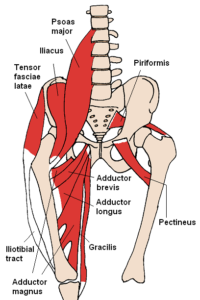No, that’s not another hip new acronym the kids are using nowadays.
Your TFL is used to describe the small muscle in your hips; Tensor Fasciae Latae. It’s located in front of your hip joint & connects to the very long tendon known as the Iliotibial band, or IT band. Your TFL aids in flexion of your hips (i.e. crunches or running); abduction of the thigh & also helps to control & keep hips level while walking/standing & may even aid in stabilization of knee.

The reason I give you a short anatomy lesson on our TFL, is because I’ve strained mine. Wahh! My family came to visit over the holidays, & about a week & a half before their arrival, my brother asked me ‘Should I bring my running shoes?’. Now ordinarily, this would be an obvious answer–um yes. Joe & I didn’t start running together until after we both moved away to college. The holidays always brought us back to our home town, and going for a run was a good way to burn off the extra holiday calories we were consuming but also a chance to get out of the house (no offense Mom & Dad!).
Fast forward to December 2016, running has not been on the agenda the past few months. Each year I managed to suffer some sort of setback–broken toe, torn ligaments in the ankle–something was slowing me down & I never fully got back into the swing of logging miles each week. When I’m in shape, I LOVE running…it’s a sort of meditation for me. But when my cardio game is lagging–running just might be one of the most torturous activities I can think of.
Anyway, I’m pretty sure 3 hours after I got off the phone with Joe, I laced up my sneakers & set out for a 3 mile jog. I continued to log 2-3 miles or a 20min treadmill run every other day until the family got here.
The day after they arrived, Joe, myself & Tonky had our first excursion.
Day 1: 7 miles

Day 2: 5 miles
Day 4: 6miles
I started getting pain on the outside of my right hip. Almost a burning sensation with an occasional shooting pain down the outside of my leg. Yes, I have health insurance, & yes maybe I should have gone to see a ‘professional’. But the usual MO from a doc is rest & take this drug. No, thanks.
First order of business, no matter the injury, is STOP any activity that causes pain. Seems obvious, but most of us are pretty stubborn & don’t follow this one simple rule.
Second, if you are seriously injured (major swelling, severe pain at the touch, blood or a bone sticking out), immediately go see a professional! But a lot of times we get these aches & pains that are not necessarily serious, but should be given some serious TLC. Most tears or strains cause inflammation in surrounding tissues. When you continue to workout without proper modifications that cater to your injury, you’re creating muscle imbalances that could lead to further injury. If your shoulder has been bothering you, time to focus strengthening your lower half. Find some sort of upper body push/pull movements that you can complete with proper form & don’t put you in agony. If you’re ok with it, take an over the counter anti-inflammatory within the first few days.
After taking some time off & letting the injury begin the healing process, it’s time to start some rehab. Obviously there are different protocols for each particular ailment, in the case of strained TFL– a low lunge variation twisting toward your front leg (affected leg should be behind you) will help stretch & open up hips. King pigeon or thread the needle for the not so advanced is another pose to stretch the hips.
Consider seeing a sports massage therapist, often times they have tools to break up scar tissue or relieve tight knotted up muscles. A lacrosse ball, or tennis ball can be used as well–lay with ball on the most tender area & move it around maintaining pressure for 10-20 seconds. This type of therapy should only be used every other day, since you might feel sore after.
The last step I recommend, after you’re healed up & ready to get back in the game is to strengthen the muscles around the injury. Again, in this case, strengthening the glutes, quadriceps & maintaining flexibility in the hips will all help to prevent future injuries.
If you’re uncertain of what to do, go see a doctor & get a Rx to see a physical therapist. They will give you all kinds of exercises that will stretch, heal, repair & re-strengthen your ailment. Yea, I get it’s annoying to make time to go see someone to tell you to do the most basic movements. But it’s a small price to pay to heal your body. You only have this one body, so you might as well take care of it while you have it!
